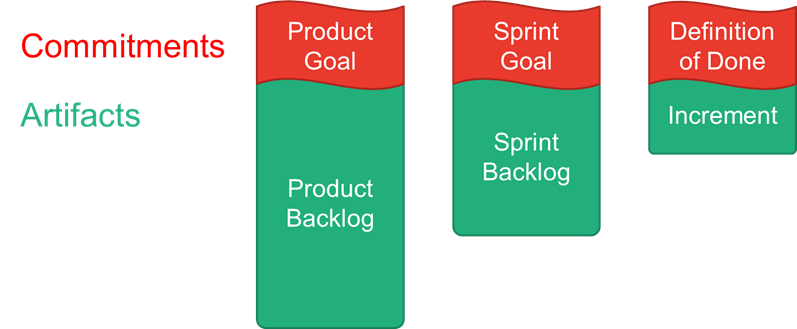A friend of mine once reported his first experiences in agile development context: „Agile development really is different. We are producing software much faster than ever before. However, the problem is that we are changing direction much too often. Within one Sprint we go in one direction and in the next Sprint we choose a new direction, sometimes even totally different to the Sprint before.“
The Scrum guide, published on November 18, 2020 by scrum.org, addresses this issue. It introduces „Product Goal“ for the product backlog. The Scrum guide states: „The Product Goal describes a future state of the product which can serve as a target for the Scrum Team to plan against.“ And further: „The Product Goal is in the product backlog. The rest of the Product Backlog emerges to define “what” will fulfill the Product Goal.“
Each artifact of the Scrum process now has a commitment associated.

Figure: Commitments and Artifacts in the Scrum guide 2020
For the sprint backlog there was already a sprint goal and for the increment there was a definition of done, enabling progress measurement towards the commitment.
Now, product backlog items can be assessed to what degree they contribute to the Product Goal. As a consequence, backlog ordering could become more transparent.
The Scrum guide states the product owner as accountable for effective product backlog management and thus responsible for: „Developing and explicitly communicating the Product Goal“.
The Product Goal provides direction for the Scrum team. This may avoid situations I described at the beginning of this blog.
It is good to see better alignment of Scrum with approaches to software product management.
As an example, consider the software product management framework from ISPMA® (https://ispma.org). Product strategy is described there as a core responsibility of product managers. Important elements of product strategy are Product Vision and product definition.
While Scrum does not explicitly refer to the term „vision“, there is a close relationship between „product vision“ and „product goal“. A product goal (or a sequence of product goals) helps to realize a product vision.
In larger organizations where the roles of product owner and product manager are performed by different people, it is often challenging to describe and establish clear responsibilities among them. Now, with the new Scrum guide there are further hints:
- The product owner is part of the scrum team
- The product owner is responsible to develop and communicate the Product Goal
Therefore, it becomes clear that the product owner and product manager should collaborate closely on the shared Product Vision and the Product Goal.
The new Scrum guide is a major edition and has many changes compared to the previous version. 10 years after the initial Scrum guide was published Scrum returns to the agile roots.
The 2020 version was created with the intention of being less prescriptive than previous versions. Actually, it has 31% less words than the previous edition. Now, agile teams have more degrees of freedom than before, so they can tackle their specific challenges even better.